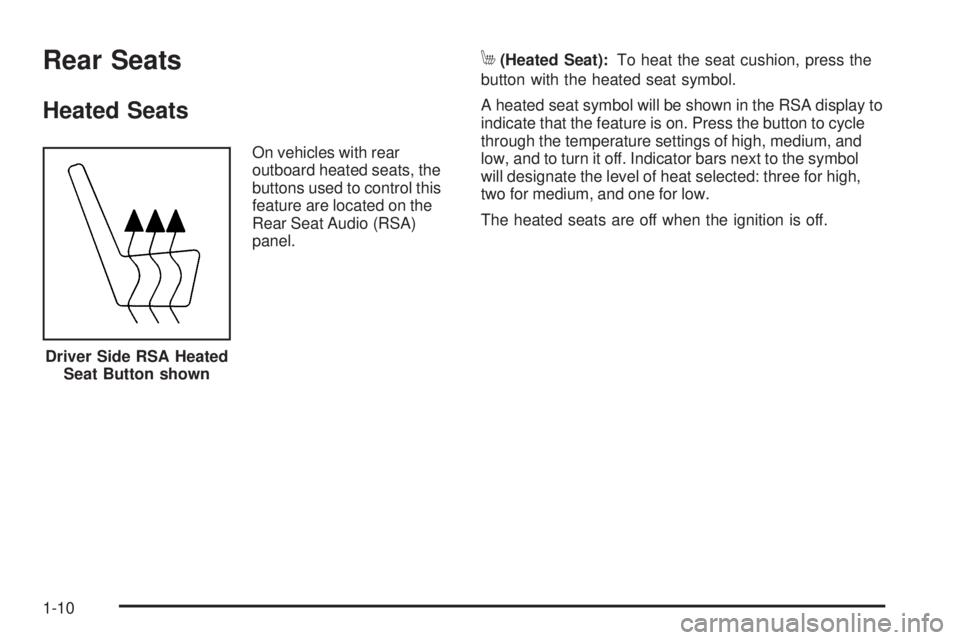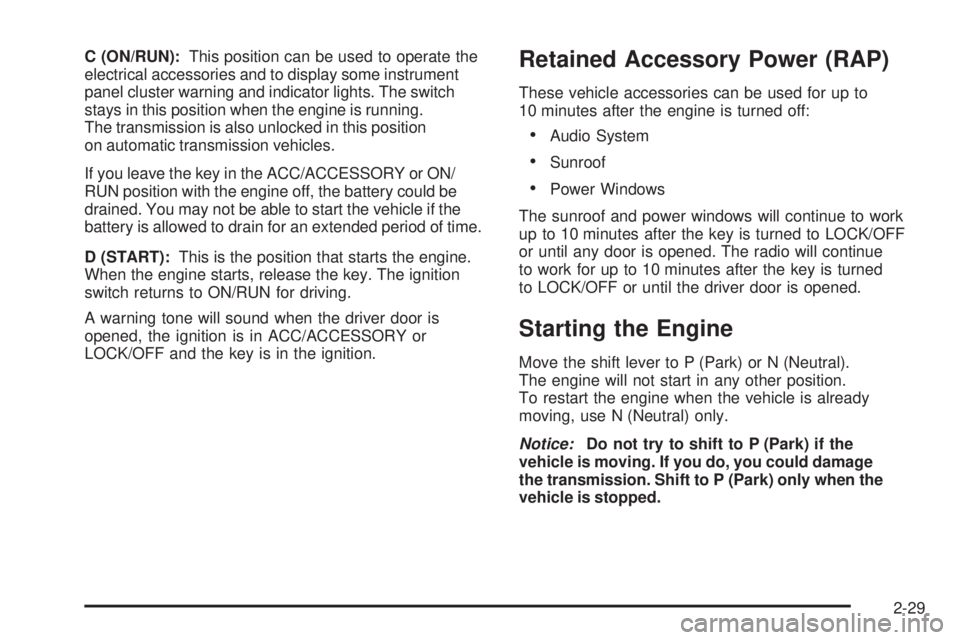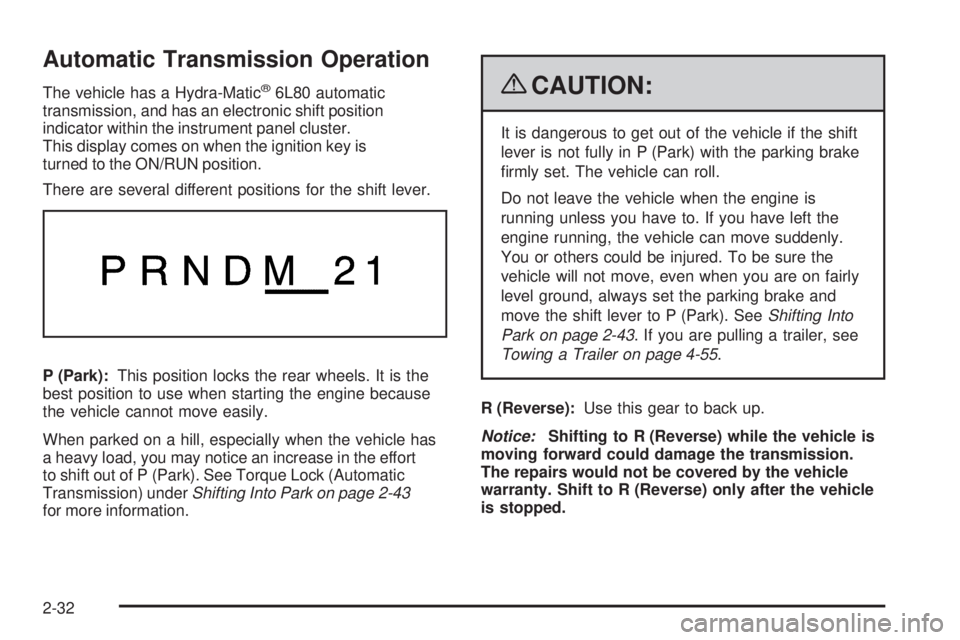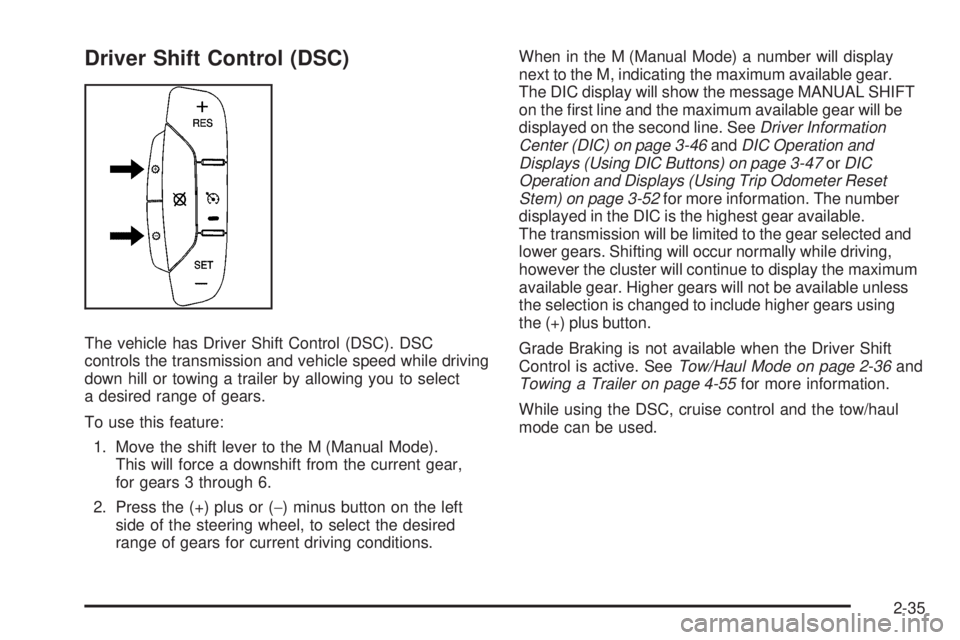display HUMMER H2 2009 Owners Manual
[x] Cancel search | Manufacturer: HUMMER, Model Year: 2009, Model line: H2, Model: HUMMER H2 2009Pages: 524, PDF Size: 3.1 MB
Page 14 of 524

Rear Seats
Heated Seats
On vehicles with rear
outboard heated seats, the
buttons used to control this
feature are located on the
Rear Seat Audio (RSA)
panel.
M(Heated Seat):To heat the seat cushion, press the
button with the heated seat symbol.
A heated seat symbol will be shown in the RSA display to
indicate that the feature is on. Press the button to cycle
through the temperature settings of high, medium, and
low, and to turn it off. Indicator bars next to the symbol
will designate the level of heat selected: three for high,
two for medium, and one for low.
The heated seats are off when the ignition is off.
Driver Side RSA Heated
Seat Button shown
1-10
Page 92 of 524

PressingKon the RKE transmitter disarms the content
theft-deterrent system. SeeContent Theft-Deterrent
on page 2-24.
Press and hold
Kto lower the windows. SeePower
Windows on page 2-20for additional information.
The remote recall memory feature may adjust the seats
and mirrors if it is on and the RKE transmitter is used to
enter the vehicle. See “MEMORY SEAT RECALL” under
DIC Vehicle Customization on page 3-64for additional
information.
L(Vehicle Locator/Panic Alarm):Press and release
to locate the vehicle. The turn signal lamps �ash and
the horn sounds three times.
Press and hold
Lfor more than two seconds to
activate the panic alarm. The turn signal lamps �ash
and the horn sounds repeatedly for 30 seconds.
The alarm turns off when the ignition is moved to
RUN or
Lis pressed again. The ignition must be
in OFF for the panic alarm to work.
Programming Transmitters to the
Vehicle
Only RKE transmitters programmed to the vehicle will
work. If a transmitter is lost or stolen, a replacement
can be purchased and programmed through your
dealer/retailer. When the replacement transmitter is
programmed to the vehicle, all remaining transmitters
must also be programmed. Any lost or stolen
transmitters no longer work once the new transmitter
is programmed. Each vehicle can have up to eight
transmitters programmed to it. See “Relearn Remote
Key” underDIC Operation and Displays (Using
DIC Buttons) on page 3-47orDIC Operation and
Displays (Using Trip Odometer Reset Stem) on
page 3-52.
Battery Replacement
Replace the battery if the REPLACE BATTERY
IN REMOTE KEY message displays in the DIC.
See “REPLACE BATTERY IN REMOTE KEY” under
DIC Warnings and Messages on page 3-56for additional
information.
Notice:When replacing the battery, do not touch
any of the circuitry on the transmitter. Static
from your body could damage the transmitter.
2-6
Page 115 of 524

C (ON/RUN):This position can be used to operate the
electrical accessories and to display some instrument
panel cluster warning and indicator lights. The switch
stays in this position when the engine is running.
The transmission is also unlocked in this position
on automatic transmission vehicles.
If you leave the key in the ACC/ACCESSORY or ON/
RUN position with the engine off, the battery could be
drained. You may not be able to start the vehicle if the
battery is allowed to drain for an extended period of time.
D (START):This is the position that starts the engine.
When the engine starts, release the key. The ignition
switch returns to ON/RUN for driving.
A warning tone will sound when the driver door is
opened, the ignition is in ACC/ACCESSORY or
LOCK/OFF and the key is in the ignition.Retained Accessory Power (RAP)
These vehicle accessories can be used for up to
10 minutes after the engine is turned off:
Audio System
Sunroof
Power Windows
The sunroof and power windows will continue to work
up to 10 minutes after the key is turned to LOCK/OFF
or until any door is opened. The radio will continue
to work for up to 10 minutes after the key is turned
to LOCK/OFF or until the driver door is opened.
Starting the Engine
Move the shift lever to P (Park) or N (Neutral).
The engine will not start in any other position.
To restart the engine when the vehicle is already
moving, use N (Neutral) only.
Notice:Do not try to shift to P (Park) if the
vehicle is moving. If you do, you could damage
the transmission. Shift to P (Park) only when the
vehicle is stopped.
2-29
Page 118 of 524

Automatic Transmission Operation
The vehicle has a Hydra-Matic®6L80 automatic
transmission, and has an electronic shift position
indicator within the instrument panel cluster.
This display comes on when the ignition key is
turned to the ON/RUN position.
There are several different positions for the shift lever.
P (Park):This position locks the rear wheels. It is the
best position to use when starting the engine because
the vehicle cannot move easily.
When parked on a hill, especially when the vehicle has
a heavy load, you may notice an increase in the effort
to shift out of P (Park). See Torque Lock (Automatic
Transmission) underShifting Into Park on page 2-43
for more information.{CAUTION:
It is dangerous to get out of the vehicle if the shift
lever is not fully in P (Park) with the parking brake
�rmly set. The vehicle can roll.
Do not leave the vehicle when the engine is
running unless you have to. If you have left the
engine running, the vehicle can move suddenly.
You or others could be injured. To be sure the
vehicle will not move, even when you are on fairly
level ground, always set the parking brake and
move the shift lever to P (Park). SeeShifting Into
Park on page 2-43. If you are pulling a trailer, see
Towing a Trailer on page 4-55.
R (Reverse):Use this gear to back up.
Notice:Shifting to R (Reverse) while the vehicle is
moving forward could damage the transmission.
The repairs would not be covered by the vehicle
warranty. Shift to R (Reverse) only after the vehicle
is stopped.
2-32
Page 121 of 524

Driver Shift Control (DSC)
The vehicle has Driver Shift Control (DSC). DSC
controls the transmission and vehicle speed while driving
down hill or towing a trailer by allowing you to select
a desired range of gears.
To use this feature:
1. Move the shift lever to the M (Manual Mode).
This will force a downshift from the current gear,
for gears 3 through 6.
2. Press the (+) plus or (−) minus button on the left
side of the steering wheel, to select the desired
range of gears for current driving conditions.When in the M (Manual Mode) a number will display
next to the M, indicating the maximum available gear.
The DIC display will show the message MANUAL SHIFT
on the �rst line and the maximum available gear will be
displayed on the second line. SeeDriver Information
Center (DIC) on page 3-46andDIC Operation and
Displays (Using DIC Buttons) on page 3-47orDIC
Operation and Displays (Using Trip Odometer Reset
Stem) on page 3-52for more information. The number
displayed in the DIC is the highest gear available.
The transmission will be limited to the gear selected and
lower gears. Shifting will occur normally while driving,
however the cluster will continue to display the maximum
available gear. Higher gears will not be available unless
the selection is changed to include higher gears using
the (+) plus button.
Grade Braking is not available when the Driver Shift
Control is active. SeeTow/Haul Mode on page 2-36and
Towing a Trailer on page 4-55for more information.
While using the DSC, cruise control and the tow/haul
mode can be used.
2-35
Page 136 of 524

Object Detection Systems
Rear Vision Camera (RVC)
This vehicle may have a Rear Vision Camera system.
Read this entire section before using it.
{CAUTION:
The Rear Vision Camera (RVC) system does not
replace driver vision. RVC does not:
Detect objects that are outside the camera’s
�eld of view, below the bumper, or
underneath the vehicle.
Detect children, pedestrians, bicyclists,
or pets.
CAUTION: (Continued)
CAUTION: (Continued)
Do not back the vehicle by only looking at the rear
vision camera screen, or use the screen during
longer, higher speed backing maneuvers or where
there could be cross-traffic. Your judged distances
using the screen will differ from actual distances.
So if you do not use proper care before backing
up, you could hit a vehicle, child, pedestrian,
bicyclist, or pet, resulting in vehicle damage,
injury, or death. Even though the vehicle has
the RVC system, always check carefully before
backing up by checking behind and around the
vehicle.
Vehicles Without Navigation System
The rear vision camera system is designed to help the
driver when backing up by displaying a view of the area
behind the vehicle. When the key is in the ON/RUN
position and the driver shifts the vehicle into R (Reverse),
the video image automatically appears on the inside rear
view mirror. Once the driver shifts out of R (Reverse),
the video image automatically disappears from the inside
rear view mirror.
2-50
Page 137 of 524

Turning the Rear Vision Camera
System Off or On
To turn off the rear vision camera system, press and
hold
z, located on the inside rearview mirror, until
the left indicator light turns off. The rear camera vision
display is now disabled.
To turn the rear vision camera system on again, press
and hold
zuntil the left indicator light illuminates.
The rear vision camera system display is now enabled
and the display will appear in the mirror normally.
Vehicles With Navigation System
The rear vision camera system is designed to help the
driver when backing up by displaying a view of the area
behind the vehicle. When the driver shifts the vehicle
into R (Reverse), the video image automatically appears
on the navigation screen. Once the driver shifts out of
R (Reverse), the navigation screen will go back to the
last screen that had been displayed, after a delay.
Turning the Rear Vision Camera System
On or Off
To turn the rear vision camera system on or off:
1. Shift into P (Park).
2. Press the MENU button to enter the con�gure
menu options, then press the MENU hard key
to select Display or touch the Display screen button.3. Select the Rear Camera Options screen button.
The Rear Camera Options screen will display.
4. Select the Video screen button. When the Video
screen button is highlighted the RVC system is on.
The delay that is received after shifting out of
R (Reverse) is approximately 10 seconds. The delay
can be cancelled by performing one of the following:
Pressing a hard key on the navigation system.
Shifting in to P (Park).
Reach a vehicle speed of 5 mph (8 km/h).
There is a message on the rear vision camera screen
that states “Check Surroundings for Safety”.
2-51
Page 138 of 524

Adjusting the Brightness and Contrast of
the Screen
To adjust the brightness and contrast of the screen,
press the MENU button while the rear vision camera
image is on the display. Any adjustments made will
only affect the rear vision camera screen.
](Brightness):Touch the + (plus) or – (minus)
screen buttons to increase or decrease the brightness
of the screen.
_(Contrast):Touch the + (plus) or – (minus) screen
buttons to increase or decrease the contrast of the
screen.
Rear Vision Camera Error Messages
Service Rear Vision Camera System:This message
can display when the system is not receiving information
it requires from other vehicle systems.
If any other problem occurs or if a problem persists, see
your dealer/retailer.
Rear Vision Camera Location
The image is provided by the camera located on the
rear bumper.
The camera uses a special lens. The distance of the
image that appears on the screen differs from the actual
distance. The area displayed by the camera is limited.
The camera does not display objects which are close
to either corner of the bumper or under the bumper.
The spare tire and carrier extends rearward of the rear
bumper. The area displayed on the screen can vary
according to vehicle orientation or road conditions.
The following illustration shows the �eld of view that the
camera provides.
2-52
Page 139 of 524

Notice:The spare tire extends farther away from
rear of the vehicle than the trailer hitch shown on rear
vision camera display. The spare tire could hit an
object even though there appears to be enough
distance on the display between the trailer hitch
and objects behind you causing vehicle or property
damage. Do not use this system to judge the distance
between the spare tire and objects behind you.
When the System Does Not Seem To
Work Properly
The rear vision camera system might not work properly
or display a clear image if:
The RVC is turned off. See “Turning the Rear
Camera System On or Off” earlier in this section.
It is dark.
The sun or the beam of headlights is shining
directly into the camera lens.
Ice, snow, mud, or anything else builds up on the
camera lens. Clean the lens, rinse it with water,
and wipe it with a soft cloth.
The back of the vehicle is in an accident, the
position and mounting angle of the camera
can change or the camera can be affected.
Be sure to have the camera and its position and
mounting angle checked at your dealer/retailer.
There are extreme temperature changes.
2-53
Page 140 of 524

The rear vision camera system display in the rearview
mirror may turn off or not appear as expected due to a
loss of video signal, or no video signal present during
the reverse cycle. The display will be blank and the left
indicator light will slowly �ash as long as the vehicle is
in R (Reverse) or until the condition returns to normal.
Pressing and holding
zwhen the left indicator light
is �ashing will turn off the video display along with the
left indicator light.
OnStar®System
OnStar uses several innovative technologies and live
advisors to provide a wide range of safety, security,
information, and convenience services. If the airbags
deploy, the system is designed to make an automatic
call to OnStar Emergency advisors who can request
emergency services be sent to your location. If the keys
are locked in the vehicle, call OnStar at 1-888-4-ONSTAR
to have a signal sent to unlock the doors. OnStarHands-Free Calling, including 30 trial minutes good
for 60 days, is available on most vehicles. OnStar
Turn-by-Turn Navigation service, with one trial route,
is available on most vehicles. Press the OnStar button
to have an OnStar advisor contact Roadside Service.
OnStar service is provided subject to the OnStar Terms
and Conditions included in the OnStar Subscriber glove
box literature.
Some services such as Remote Door Unlock or Stolen
Vehicle Location Assistance may not be available until
the owner of the vehicle registers with OnStar. After the
�rst prepaid year, contact OnStar to select a monthly or
annual subscription payment plan. If a payment plan
is not selected, the OnStar system and all services,
including airbag noti�cation and emergency services,
may be deactivated and no longer available. For more
information visit onstar.com (U.S.) or onstar.ca (Canada),
or press the OnStar button to speak with an advisor.
Not all OnStar services are available on all vehicles.
To check if this vehicle is able to provide the services
described below, or for a full description of OnStar
services and system limitations, see the OnStar Owner’s
Guide in the glove box or visit onstar.com (U.S.) or
onstar.ca (Canada), contact OnStar at 1-888-4-ONSTAR
(1-888-466-7827) or TTY 1-877-248-2080, or press the
OnStar button to speak with an OnStar advisor 24 hours
a day, 7 days a week.
2-54